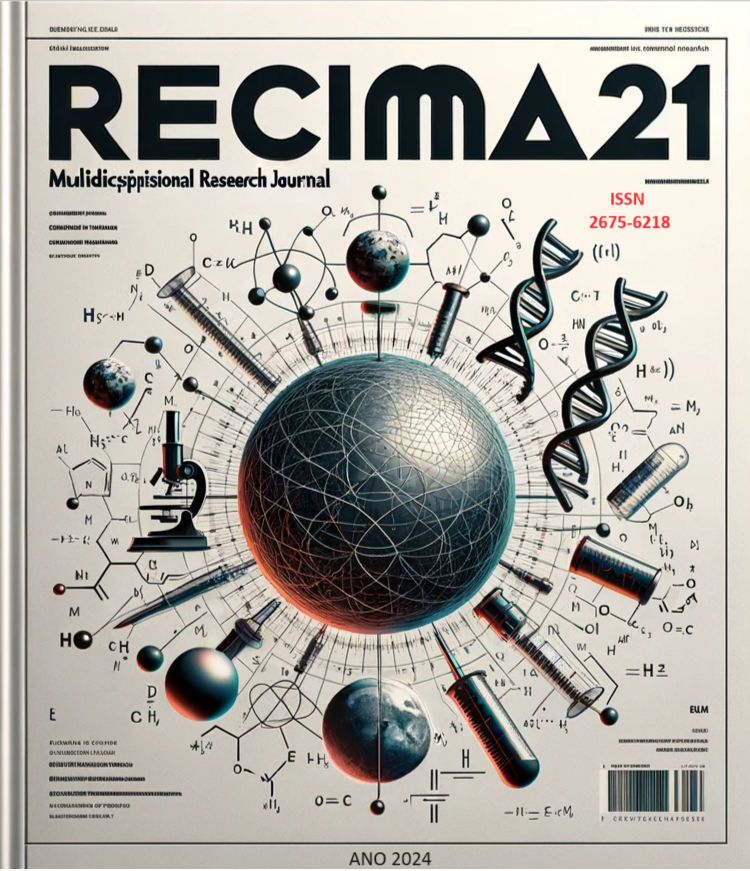CÓMO LA FISIOPATOLOGÍA DEL SÍNDROME DE GILBERT AFECTA LA VIDA COTIDIANA DE LOS PACIENTES PORTADORES: UNA REVISIÓN INTEGRATIVA
DOI:
https://doi.org/10.47820/recima21.v5i10.5731Palabras clave:
Síndrome de Gilbert, UDP-glucuroniltransferasa, SíndromeResumen
El síndrome de Gilbert (SG) se configura como una patología hereditaria, en la que se produce una mutación en el gen UGT1A1, reduciendo la actividad de la enzima UDP-glucuroniltransferasa, cuya consecuencia es cambiar los niveles de bilirrubina no conjugada en la sangre, generando hiperbilirrubinemia. Este exceso de bilirrubina indirecta de suero puede conducir a varias manifestaciones clínicas. A través del presente estudio, se observó que los síntomas pueden presentarse de una manera maliciosa y beneficiosa. Entre los daños, la ictericia, el dolor epigástrico y la falta de energía se destacan. En la otra mano, las protecciones cardiovasculares y los efectos antioxidantes caracterizan algunos de los beneficios de esta mutación. El diagnóstico requiere, además de las pruebas complementarias, una evaluación de los niveles de suero de bilirrubina total. Se observa que el aumento exacerbado en la bilirrubina indirecta está influenciado por varios factores, como la etnia, el fumar, los hábitos alimenticios, la genética y el sexo. Además, se configura como una molécula con efectos anti-inflamatorios, antiaterógenos, antitrombóticos e inmunomoduladores, pero se informa un mayor riesgo de desarrollar diabetes mellitus, câncer de colon y cáncer de mama. SG es frecuente en los hombres y no requiere tratamiento farmacoterapéutico o dietético, sin embargo, un seguimiento especializado debe llevarse a cabo periódicamente.
Descargas
Referencias
ALIARAB, Azadeh et al. Effect of gilbert's syndrome associated polymorphic alleles (rs8175347 and rs4148323) of UDP-glucuronyl transferase on serum bilirubin level. Meta Gene, v. 26, p. 100788, 2020. DOI: https://doi.org/10.1016/j.mgene.2020.100788
EREMIASOVA, Lenka et al. Serum Bilirubin in the Czech Population―Relationship to the Risk of Myocardial Infarction in Males―. Circulation Journal, v. 84, n. 10, p. 1779-1785, 2020. DOI: https://doi.org/10.1253/circj.CJ-20-0192
GU, Leilei et al. Genetic testing of UGT1A1 in the diagnosis of Gilbert syndrome: The discovery of seven novel variants in the Chinese population. Molecular Genetics & Genomic Medicine, v. 10, n. 7, p. e1958, 2022. DOI: https://doi.org/10.1002/mgg3.1958
HANA, Claudia A. et al. Serum metabolomics analysis reveals increased lipid catabolism in mildly hyperbilirubinemic Gilbert's syndrome individuals. Metabolism, v. 125, p. 154913, 2021. DOI: https://doi.org/10.1016/j.metabol.2021.154913
HSU, Paul Wei-Che et al. The mutation hotspots at UGT1A locus may Be associated with gilbert’s syndrome affecting the Taiwanese population. International Journal of Molecular Sciences, v. 23, n. 20, p. 12709, 2022. DOI: https://doi.org/10.3390/ijms232012709
HUANG, May‐Jen et al. Effect of UDP‐glucuronosyltransferase 1A1 activity on risk for developing Gilbert's syndrome. The Kaohsiung Journal of Medical Sciences, v. 35, n. 7, p. 432-439, 2019. DOI: https://doi.org/10.1002/kjm2.12077
HUANG, May‐Jen; CHEN, Pei‐Lain; HUANG, Ching‐Shan. Bilirubin metabolism and UDP‐glucuronosyltransferase 1A1 variants in Asians: Pathogenic implications and therapeutic response. The Kaohsiung Journal of Medical Sciences, v. 38, n. 8, p. 729-738, 2022. DOI: https://doi.org/10.1002/kjm2.12579
KAMAL, Sanaa et al. The frequency, clinical course, and health related quality of life in adults with Gilbert’s syndrome: a longitudinal study. BMC gastroenterology, v. 19, p. 1-14, 2019. DOI: https://doi.org/10.1186/s12876-019-0931-2
KANG, Ling-Ling; MA, Yong-Jian; ZHANG, Hou-De. Carbon monoxide breath test assessment of mild hemolysis in Gilbert's syndrome. Medicine, v. 99, n. 7, p. e19109, 2020. DOI: https://doi.org/10.1097/MD.0000000000019109
MI, Xiao-xiao et al. Analysis of the UGT1A1 genotype in hyperbilirubinemia patients: differences in allele frequency and distribution. BioMed Research International, v. 2019, n. 1, p. 6272174, 2019. DOI: https://doi.org/10.1155/2019/6272174
RAVINDRAN, Ravi Rajan. Jaundice. Surgery (Oxford), v. 38, n. 8, p. 446-452, 2020. DOI: https://doi.org/10.1016/j.mpsur.2020.06.008
SOOD, Vikrant et al. Gilbert’s syndrome in children with unconjugated hyperbilirubinemia–an analysis of 170 cases. The Indian Journal of Pediatrics, v. 88, p. 154-157, 2021. DOI: https://doi.org/10.1007/s12098-020-03271-6
SULTAN, Amir; KIFLU, Kibrewossen. Gilbert syndrome in a young Ethiopian man: first case report. Ethiopian Journal of Health Sciences, v. 31, n. 1, 2021. DOI: https://doi.org/10.4314/ejhs.v31i1.23
VITEK, Libor et al. The physiology of bilirubin: health and disease equilibrium. Trends in molecular medicine, v. 29, n. 4, p. 315-328, 2023. DOI: https://doi.org/10.1016/j.molmed.2023.01.007
VITEK, Libor; BELLAROSA, Cristina; TIRIBELLI, Claudio. Induction of mild hyperbilirubinemia: hype or real therapeutic opportunity?. Clinical Pharmacology & Therapeutics, v. 106, n. 3, p. 568-575, 2019. DOI: https://doi.org/10.1002/cpt.1341
VÍTEK, Libor; TIRIBELLI, Claudio. Gilbert´ s syndrome revisited. Journal of hepatology, 2023. DOI: https://doi.org/10.1016/j.jhep.2023.06.004
YAO, Miao-En et al. Physiologically increased total bilirubin is associated with reduced risk of first myocardial infarction: a meta-analysis and dose-response analysis. Nutrition, Metabolism and Cardiovascular Diseases, v. 31, n. 4, p. 1016-1026, 2021. DOI: https://doi.org/10.1016/j.numecd.2021.01.002
YAO, Qing et al. Therapeutic application and construction of bilirubin incorporated nanoparticles. Journal of Controlled Release, v. 328, p. 407-424, 2020. DOI: https://doi.org/10.1016/j.jconrel.2020.08.054
ZHANG, Meng et al. Compound heterozygous UGT1A1* 28 and UGT1A1* 6 or single homozygous UGT1A1* 28 are major genotypes associated with Gilbert’s syndrome in Chinese Han people. Gene, v. 781, p. 145526, 2021. DOI: https://doi.org/10.1016/j.gene.2021.145526
ZÖHRER, Patrick A. et al. Gilbert’s syndrome and the gut microbiota–insights from the case-control BILIHEALTH study. Frontiers in cellular and infection microbiology, v. 11, p. 701109, 2021. DOI: https://doi.org/10.3389/fcimb.2021.701109
Descargas
Publicado
Número
Sección
Categorías
Licencia
Derechos de autor 2024 RECIMA21 - Revista Científica Multidisciplinar - ISSN 2675-6218

Esta obra está bajo una licencia internacional Creative Commons Atribución 4.0.
Os direitos autorais dos artigos/resenhas/TCCs publicados pertecem à revista RECIMA21, e seguem o padrão Creative Commons (CC BY 4.0), permitindo a cópia ou reprodução, desde que cite a fonte e respeite os direitos dos autores e contenham menção aos mesmos nos créditos. Toda e qualquer obra publicada na revista, seu conteúdo é de responsabilidade dos autores, cabendo a RECIMA21 apenas ser o veículo de divulgação, seguindo os padrões nacionais e internacionais de publicação.













